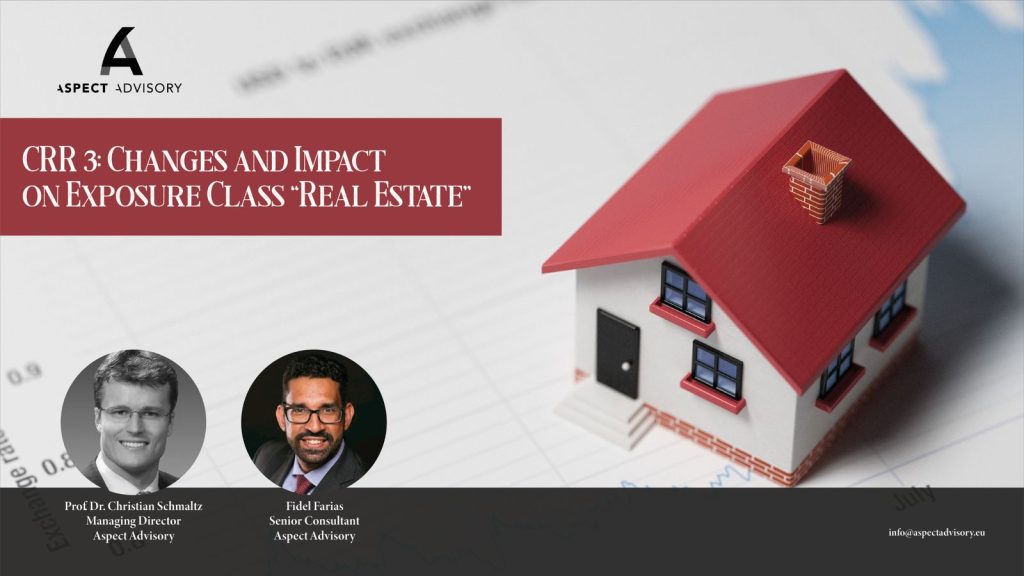
More granularity for a complex market
The Economist recently reported that Real Estate is the largest asset class in the world, making up 68% of the world’s non-financial assets in 2020.[1] It naturally follows then that a large portion of European banks’ lending is dedicated to real estate. This is the latest asset class to come under the spotlight as renewed recession fears in the sector grow. Real estate loans are typically paid back by their borrowers’ income or by the income (rent) that the real estate generates. If the income reduces or disappears, the bank can sell the property (hopefully) covering in full the outstanding loan amount and interest payments. None of the risks are hedgeable: not the income risk of individual borrowers nor the income risk of rented properties nor the price risk of properties. Recessions and real estate crises could therefore destabilize banks if they had taken on too much of these real estate risks. Regulators whose job is to prevent banks’ failure are therefore especially attentive to real estate risks:
- Real estate risks are closely monitored by the European Systemic Risk Board:
Over the past five years it has issued warnings on medium-term vulnerabilities in the Czech, German, French, Icelandic, Norwegian, Belgian, Danish, Luxembourgish, Dutch, Finish, and Swedish real estate markets. Some warnings have been accompanied by requiring banks to prepare extra anti-cyclical capital buffers against potential losses from real estate lending.
- Commercial real estate lending is a focus topic on the SSM’s supervisory agenda 2021/ 22.
During and after the pandemic, working- and shopping behavior have shifted towards peoples home and online reducing the demand and thus creditworthiness for commercial real estate. The SSM supervisors fear that the financial stability of large lenders in commercial real estate might actually be compromised.
- Real estate lending is a focus area of CRR III – the next generation of banking regulation.
The CRR III – mandatory for all European banks from Ireland to Greece, and Spain to Finland – introduces small changes in many areas. However, the big changes are on real estate lending and their treatment under the standardized approach for credit risk.
This article is dedicated to 3. and describes the required changes and particular implementation challenges we have encountered through our CRR III projects.
The draft amendment to the Capital Requirements Regulation (CRR 3) was published by the European Parliament in 2021. The new mortgage requirements under the standardized approach are to be applied from 1 January 2025 onwards. They consist of 4 key changes targeting one common goal: measuring real estate risk under the standardized approach more accurately. Thus, where very different risks obtain the same risk weight in real estate lending under today’s standardized approach, they will obtain different, more appropriate risk weights in the CRR III’s standardized approach. More risk-sensitive risk weights reduce the competitive advantage that large banks have through their Internal Rating-based Approaches where risk weights are already risk-sensitive since 2007.
“How high property prices can damage the economy”, The Economist, July 2022.
The four key changes are as follows:
No | Key changes | Motivation and impact |
1 | Introduction of the new exposure class ADC and the new sub-exposure class “IPRE”: Residential mortgages\ non-IPRE Commercial mortgages\ non-IPRE Commercial mortgages\ IPRE ADC | Previous real estate crises have evidenced higher risks for ‘Income Producing Real Estate’ (whose repayment ability is mainly generated by the cash flow produced by the property) and loans for ‘Acquisition, Development and Construction’ (ADC). This is acknowledged by separate (sub-)exposure classes (IPRE, ADC) with higher risk weights. |
2 | If operational criteria re not fulfilled, the assigned risk weight is substantially higher. | Previous real estate crises have evidenced that banks’ losses are lower if the property has been fully completed, the bank holds the first lien, the property value is not materially dependent upon the credit quality of the obligor, the information on borrower and property are comprehensively documented, and the property has been prudently valued. |
3 | Introduction of Whole Loan (WL) approach as alternative to existing Loan Split (LS) approach | Both approaches determine the appropriate risk weights based on the Exposure-to-Value where Exposure = Outstanding loan amount and Value = prudently valued property. The new WL approach is the global standard and assigns one single risk weight to the real estate exposure. The LS approach splits the loan amount at 55% * value into a (real estate-) secured and an unsecured portion. Banks can (and should) choose either approach based on their portfolio characteristics. |
4 | More risk-sensitive risk weights | The risk weights for low risk exposures (= low ETVs) have been lowered and for high risk exposures (high ETVs, operational criteria not fulfilled, subordinated liens, ADC, IPRE, etc.) have been increased. |
In what follows, we describe the pertinent details and implications of these changes.
1 New exposure classes
The CRR 3 draft defines the IPRE (‘income producing real estate’) and ADC (‘acquisition, development and construction’) exposure as separate lending segments that deserve separate risk weights. This differentiation is in addition to the existing one between residential and commercial real estate. The IPRE represents real estate mortgages whose repayment ability is mainly generated by the cash flow produced by the property. The ADC represents real estate mortgages to companies with the purpose of financing land acquisition for development and construction purposes or the development and construction of any residential or commercial property. Like IPRE they receive a separate treatment under CRR 3.
2 Operational criteria
One of the most prominent operational criteria is the one of prudent property valuation.
The question of the valuation of the property was indeed intensively discussed after the publication of the Basel requirements. While the Basel rules require the recognition of the value of the real estate at the time the loan is granted and for an adjustment of this value only in exceptional circumstances, the CRR explicitly allows institutions to use more current market values as a basis, provided that regular monitoring and impairment testing is assessed independently by a suitably qualified valuer. This should be the market standard, especially for German institutions with MaRisk requirements. An upward adjustment (even beyond the market value at the time of lending) is limited to the average values of the last three (for commercial) or six (for residential) years. For example, in Switzerland, the regulatory value (relevant for the ETV) is typically capped at the market value of origination for 7 years.
3 Whole Loan approach
CRR 3 preserves the loan splitting approach for residential and commercial property. This current approach divides mortgage exposures into a secured (≤ 55% property value) and an unsecured portion (> 55% property value) and assigns the appropriate risk weight to each of these two portions. However, the CRR 3 lowered the risk-weight of the secured portion from 35% to 20%. Unchanged is the application of the risk weight of the counterparty to unsecured remainder of the exposure. Furthermore, for residential mortgages, CRR 3 provides also a more risk-sensitive exposure-to-value (ETV) ratio-based endorsement treatment which is called the WL approach. The WL approach assigns a single risk weight depending on the ETV.
Commercial real estate is likewise covered by the LS approach. However, the application of this approach must be approved by the national supervisor, once the “hard test rule” has been carried out. If loss rates from commercial real estate lending do not exceed certain limits (“hard test”), national competent authorities may allow the rules for “classic” real estate exposures to be applied.
CRR 3 permits banks to employ any of the two alternate approaches: specifically, the Whole Loan (WL) approach and the Loan Splitting (LS) Approach. According to our CRR 3 impact studies, the LS showed the less RWA-intensive approach. The results show that both the residential and the commercial sectors have lower levels of RWA.
4 Amended Risk Weights
In the specifical case of real estate, the changes of the regulation are focused on adjustment of risk weights. Thus, low risk exposures secured by mortgages on residential property can apply a favorable risk weight until 2032 or 2029, depending on certain defined conditions.
Considering exposures of residential property in the WL approach, the risk weight ranges from 20% to 70% for Non IPRE exposures, and between 30% and 105% for the IPRE property exposures depending on the ETV. In the case of commercial properties in the WL approach, risk weights are higher than for residential properties ranging from 60% to 70% for Non IPRE exposures, and from 70% and 150% for IPRE exposures. For instance, CRR 3 assigns a risk weight of 70% for IPRE when the ETV is less than 60%, 90% when ETV is between 60% and 80%, and 110% when ETV is greater than 80%.
CRR 3 introduces a higher risk sensitivity than the current regulation: where CRR 2 applies under the LS approach a risk weight of 35% for secure mortgages on residential properties and 50% for the commercial real estate, CRR 3 applies under the LS approach a 20% for the residential properties and 60% for the secure mortgages of commercial real estate.
A much-discussed point of the Basel framework was the requirements for ADC mortgage. They were classified as a speculative real estate mortgage under the CRR 2. The CRR 3 draft now confirms this higher riskiness of ADC mortgages but changes its risk-weighting approach by removing it from the speculative segment and honoring it by its own ADC segment. The risk weight of 150% assigned to ADC can be reduced to 100% if the contractual conditions are fulfilled (Article 126a paragraph 2).
Challenges during the implementation
Regarding implementation of the regulation, the banks face some challenges and complexities to adjust the real estate exposure risk asset to the new risk sensitive methodology, while the success of implementation will depend largely on the data quality of the bank.
The three main challenges according to our CRR 3 assignments are:
- The calculation of the Exposure-to-Value: The ETV is necessary to assign a risk weight to its respective mortgage. This indicator is calculated by dividing the amount of loans tied to the bank by the appraised value or the purchase price of the property. This information represents one of the main data GAPs observed during our CRR 3 implementation projects. The aggregation of multiple risk exposures of the same bank or external banks linked to the same property shows how complex the loan structure can be. Often banks do not dispose of data regarding foreign liens held by external banks. Therefore, the computation of this exposure is a particular challenge and requires detailed questions to the borrowers during the lending process.
- Optimization and adjustment of the ID Property: The use of unique IDs for properties collateralizing multiple exposures is key for the optimal calculation of RWAs of CRR 3.
- Determination of the intended property use: This indicator addresses of the main criteria which is the identification of IPRE and Non IPRE properties. IPRE are real estate loans for office building, multi-family residential buildings, hotels and warehouse. Primary source of repayment of loans is from income produced by underlying real estate owner-occupied or rented of the property.
In summary, given the elevated probability of recession in the Real Estate sector we are seeing, the changes in the real estate exposure class are significant and relevant for the calculation of the RWA of the Standardized Approach. One of the main complexities that the banks will have during the implementation are related to the Data Gap between the CRR 2 and CRR 3 and the adjustment of the current dataset structure. In essence, the following question could be addressed by the banks during the implementation: How should the bank address the changes referred to identification of subordinated debt of a mortgage, determination of lien ranks and the optimization of a property ID to calculate an optimal ETV?
Contact us

